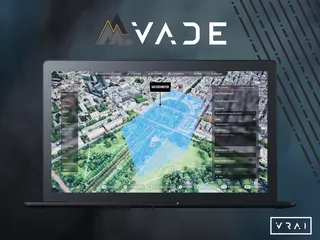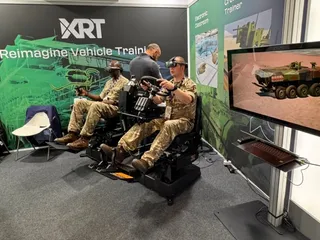Airbus – Brand New Training
Contact Our Team
For more information about how Halldale can add value to your marketing and promotional campaigns or to discuss event exhibitor and sponsorship opportunities, contact our team to find out more
The Americas -
holly.foster@halldale.com
Rest of World -
jeremy@halldale.com

The arrival of the Airbus A350 XWB has served as a catalyst for Airbus to re-think the training tasks essential in support of its aircraft. Chris Long visited Airbus in Toulouse for an update.
Now branded as “Training by Airbus”, the roll out of this training model has been triggered by increasing global demand. Fabrice Hamel, Vice President Training Services, presents the ongoing expansion of the Airbus Training network, which presently features its existing centres at Toulouse, Hamburg, Miami, Bangalore and Beijing, but will shortly embrace Mexico City (in 2015) and Singapore (in 2015) all of which offer one-stop-shop training on all Airbus types, and the A320 Training Centre Delhi. Nor will that expansion stop there. The principle of providing training closer to the customer airlines will see more sites coming on stream in the future. Only these centres will provide the Airbus branded and approved syllabus and training tools. Other training organisations deliver their own syllabus which matches the requirements of local regulators.
New Training Philosophy
Alongside the development of these training facilities, Airbus has continued its evolution in training tools and methodology. Naturally, it is still essential to understand the individual systems, but to a far greater extent than earlier generation aircraft, the relationship and interaction between all the systems needs to be thoroughly assimilated. To achieve this big picture view of the aircraft, the underlying principles have also been adapted, with “Learning by Doing” being facilitated through extensive use of the virtual aircraft to explore and understand the systems and their interdependence.
Alongside this change, the sequencing of the training has been adapted to make use of these new capabilities. Gone is the relatively sterile formula of intensive, classroom-based theoretical training followed by a staged progression in practical training. Now, as soon as a concept or introduction to a system is addressed, there is immediate access to a virtual aircraft to demonstrate the relevance and practical use of that knowledge.
Adaptive Tools
Several platforms are used to deliver this new training syllabus. Most of them are familiar in principle, but their capabilities have been expanded to encompass the broader syllabus now being used. The breakdown of systems is clearly explained on the tablet issued to trainees. The virtual aircraft is available on this device, and free exploration of operations is encouraged. This is not gaming, but the free-play allows the effect of operations on groups of associated systems to be immediately seen and learnt.
For maintenance crews this Airbus Competence Training (ACT) provides a clear understanding, and presents the information in an engaging format. It has proven not only to be popular with the trainees, but, critically, has been shown to be much more effective for the long-term retention of knowledge. There is also a significant reduction (50%) in the time needed for training on an actual aircraft - an attractive option for the accountants. Integrated into this is training for the Cockpit Onboard Maintenance Terminal and Air Nav - a source of all maintenance manuals, which, just like the systems, are interlinked. Immediate access to this information during both training and day-to-day operations gives a tool which is both familiar and all-encompassing.
Airbus Cockpit Experience (ACE)
The design and shaping of the training pattern for the A350XWB was first covered in CAT 3/2012. A primary tool developed during that process, the Airbus Cockpit Experience (ACE), is now mature, and has built up considerable time in training the crews of the first operators. The concept has proven to be very effective and, importantly, particularly popular with those doing the courses. Consequently retention of critical information has improved.
Underlying the baseline parameters for this pattern are Evidence Based Training, Threat and Error Management and Competency Based Training. These have all moved well beyond mere academic theory and are now completely embedded in the ACE. As with the ACT, the key is to combine interactivity and Learning by Discovery with alternating exposure to the theory and practical elements of the training. This pattern is also characterised by the early introduction and use of the virtual aircraft, the APT+ (an upgraded Airbus Procedure Trainer) and the full flight simulator (FFS), the latter as early as day eight of the course. An underlying theme is that the “Need to Understand” is heavily emphasised, so that the days of simply learning by rote in order to pass the end-of-course tests are long gone.
It has sadly become evident during the investigation of incidents and accidents that the “Startle” or “Surprise” factor which occurs during abnormal/emergency situations can seriously impair flight crew performance and their reaction to those situations. Having absorbed that information, the Airbus team now integrate those factors into the practical phase of the training, largely carried out on the APT+ and the FFS. Given that a lot of the training is now scenario-based, it is possible to incorporate a wide range of unscheduled events, and thereby help crews to learn how to control their own reaction to unexpected occurrences. This is part of the training - not a pass/fail test.
When fly-by-wire aircraft were first introduced, it was assumed that the then current generation of pilots had a well-established competency in basic manual flying. The aim of the conversion to the new generation aircraft was primarily to familiarise pilots with the improved automated aids to flying. The world has moved on, and pilots coming to the Type Rating courses, even those crews with a high number of hours, do not necessarily have the same underlying confidence and competence in manual flying. So, in a reversal of sequencing of the initial practical training activity, considerable emphasis is now placed on manual flying skills.
As mentioned in the earlier article, the first four sessions in the FFS focus on manual flying of all phases of flight, thereby establishing an understanding and confidence in the basic A350 platform. Only then are the huge range of automated options gradually introduced to lead to the ability to operate the aircraft with the maximum of safety and efficiency.
Assessment
However carefully the development team at Airbus had designed the training pattern, the proof of its effectiveness has to come from those outside Airbus itself - the customer airlines and the regulators. During the period July - September 2014, some 16 airline pilots with either FAA or EASA licences completed the course, together with four evaluators from EASA and the FAA. This group included pilots who had no experience of Airbus aircraft. They were given the course appropriate to their experience. Those who had not flown Airbus types before inevitably had the longest course, whilst others completed the Cross Crew Qualification (CCQ) course suited to their experience.
Airbus is keen to report that the feedback was uniformly positive. This new philosophy and pattern was apparently very well received by the control group. Some of the quotes of “Learning by Discovery big thumbs up”, “I’m happy to say that you got it right” and “potential of the new learning tools is fantastic”, give an indication that evolving the training to match new tasks and learning processes to the culture of the current generation of pilots has been successful.
Further Proof
CAT was present at the delivery of the first A350 XWB in Toulouse in December 2014. This was to Qatar Airways, who have themselves established a reputation as a customer who expects to get the highest standards of product to facilitate the delivery of their own target of excellence. The satisfaction expressed during the handover ceremony praised the overall preparation for entry into service of the new aircraft. The flight and cabin crews relished the opportunity to operate a state-of-the-art aircraft and felt confident in being able to deliver that in future operation.
Certainly the demonstration flight gave every indication that the operating crews were competent and confident in their role, so demonstrably the training has worked for the new team.


